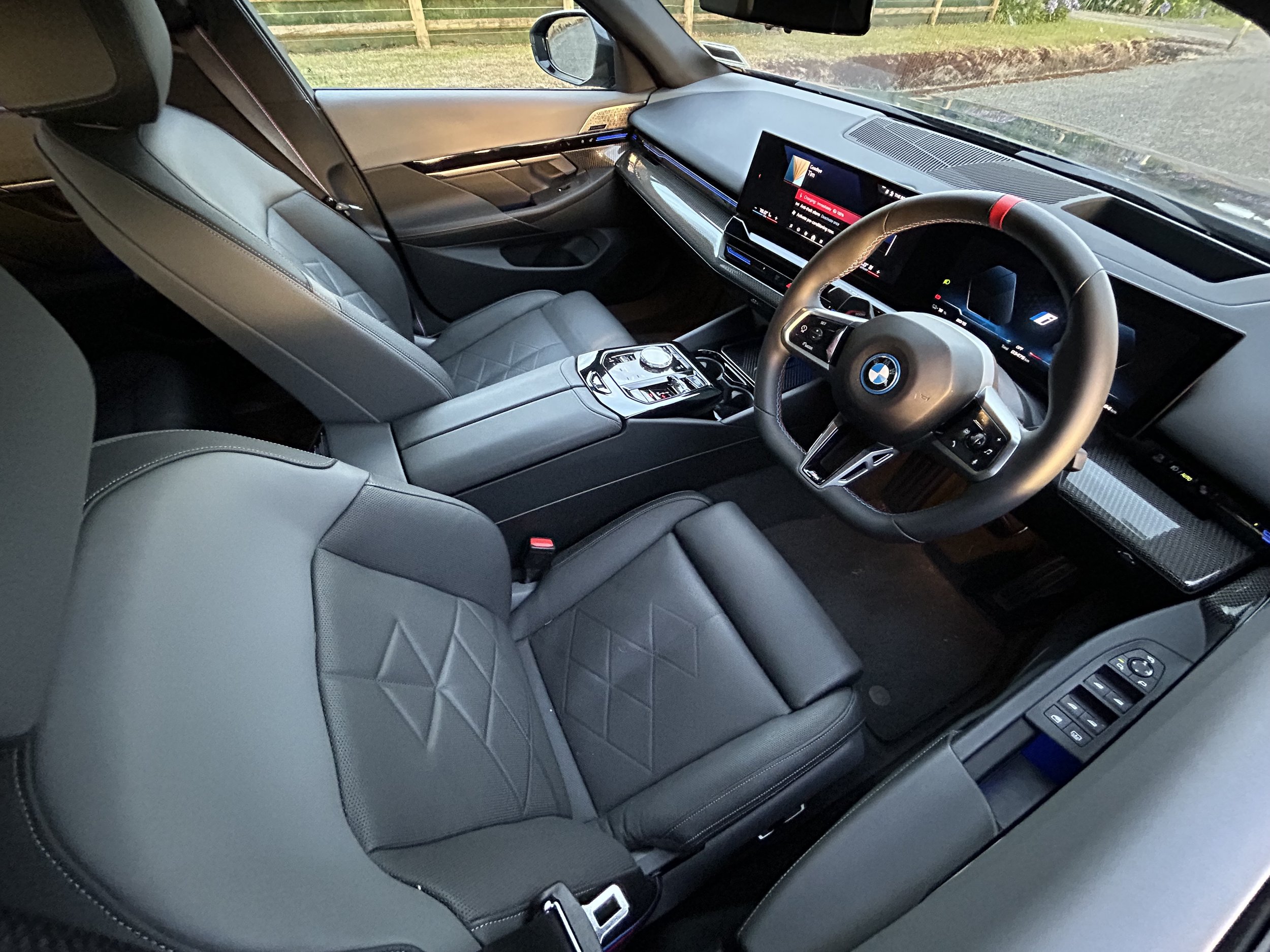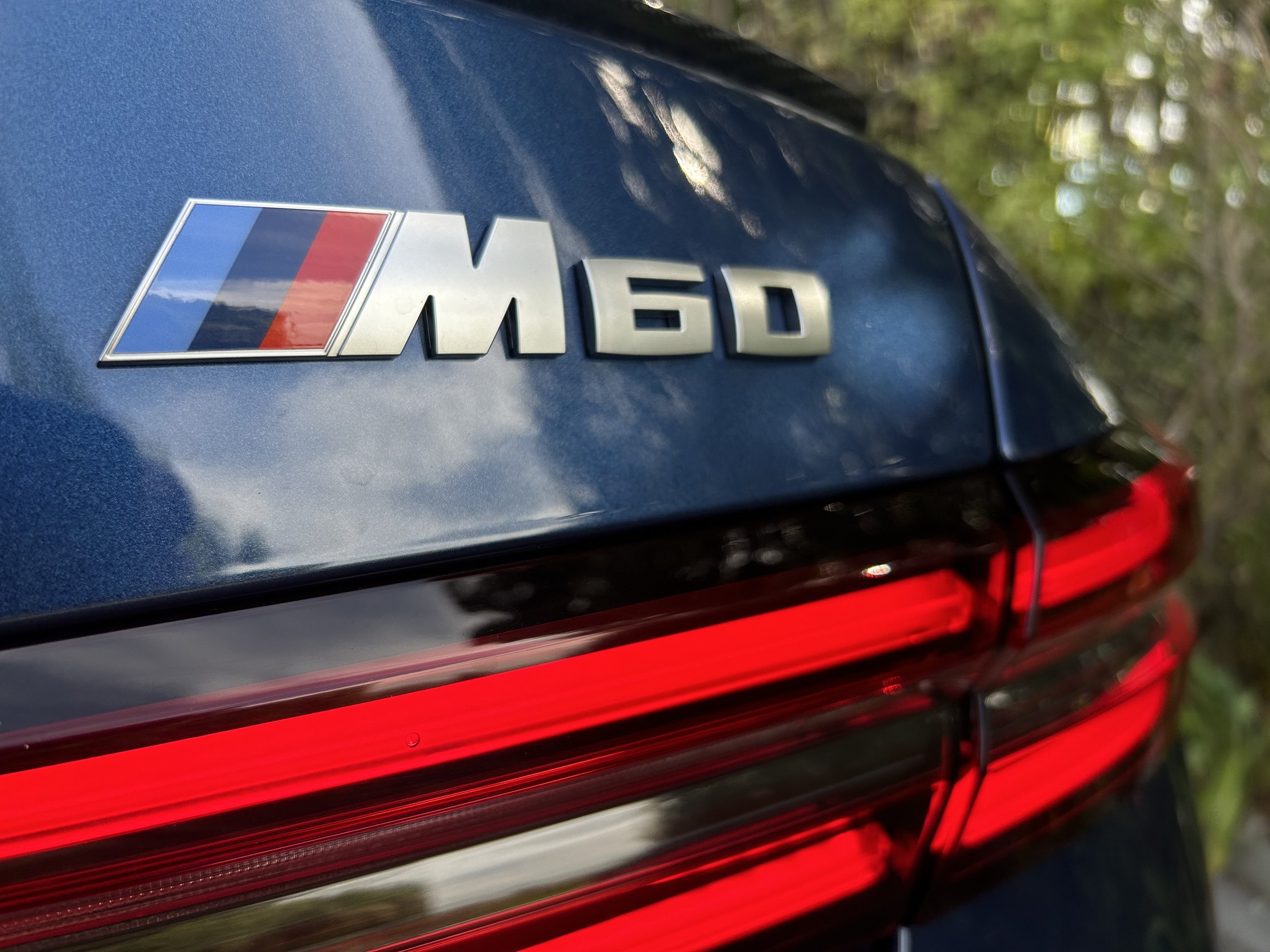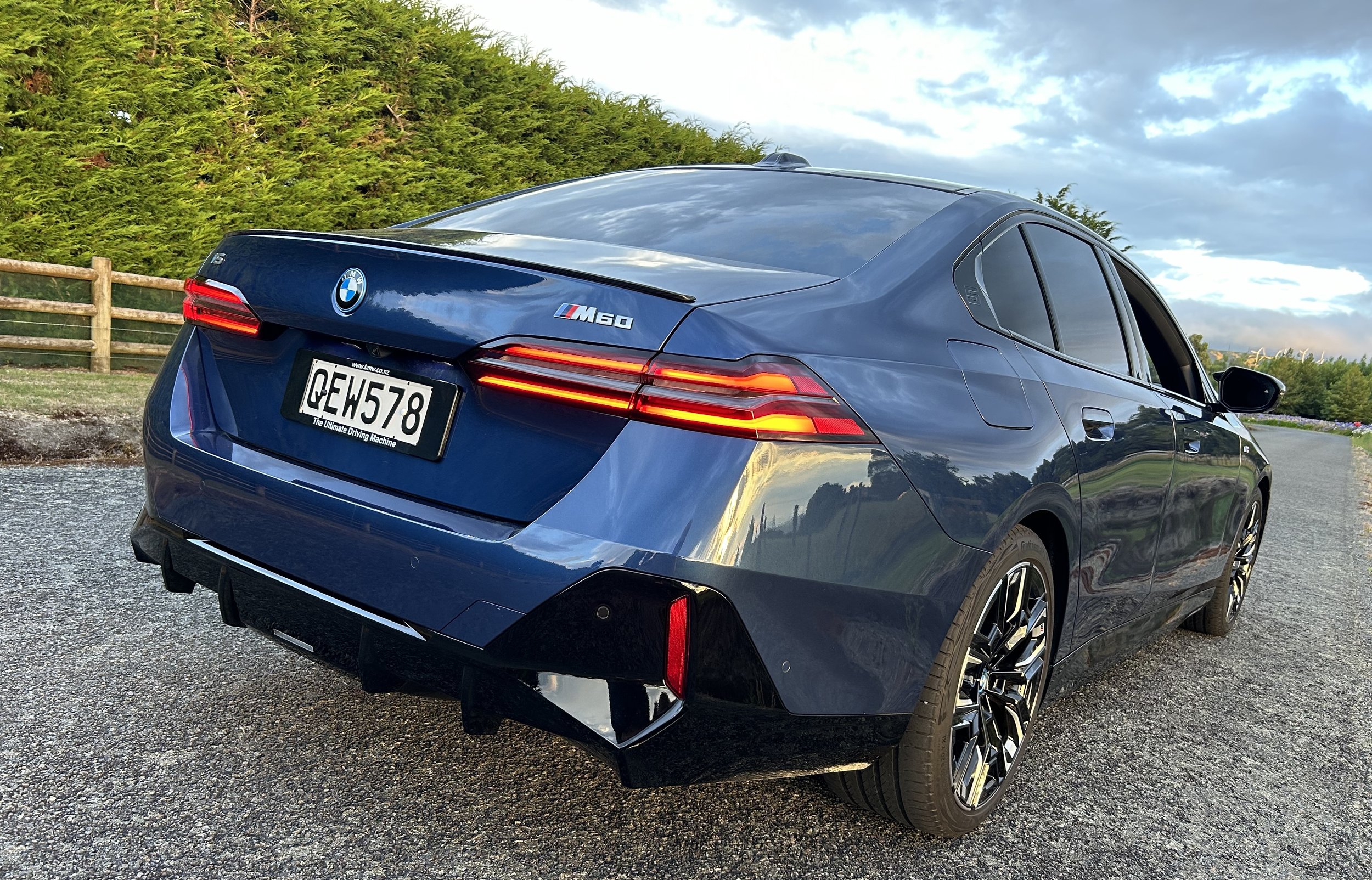BMW i5 M60 xDrive: Electric revives a prime number
/A hugely capable machine that drives fantastically well; but will it revive interest in the kind of car this brand does best?
Price: $196,900.
Powertrain: Dual electro synchronous motor, 442kW/880Nm, single speed.
How big: 5060mm long, 1900mm wide, 1508mm tall, 2995mm wheelbase.
We like: Ticks all the BMW-ness boxes; better driving experience than an X model.
Not so much: Operating system an app overload.
CONDENSATION across the windscreen - hardly an unusual thing, except …
… no matter how hard the ventilation was blowing, now matter where the airflow was directed, no matter how warm the setting … the mist remained.
Making the situation all the more surreal - this played out at a roadworks entering the Taranaki township of Stratford, shortly after midnight.
It was steamy hot. Five minutes prior, a thunderstorm, but now the sky was clear. Our car was at the head of a line of traffic, awaiting the green. And I couldn’t see a thing straight ahead.
My wife suggested using the wipers. It seemed a desperate idea. Surely the issue was on the inside of the screen? But Carol was spot on. With a single blade sweep, vision was restored.
In hindsight, fossil fuel cars create heat; in this circumstance, there would have been enough to waft across the glass, keeping it clear.
It wasn’t an issue when BMW’s first electric Five Series was romping down the highway; the air flow had been enough to keep the windscreen demisted.
It was stopping for nigh on 10 minutes that created the issue; likely exacerbated by the air con running a cool temp. Lesson learned.
This drive had been a last minute thing. I was keen to try the new i5 on a relatively long roadie. A quick return run to New Plymouth, three and a half hours there, same again back, for the last night of the famous Festival of Lights illuminations within Pukekura Park. An electric show pony to see a famous electric show.
The Five Series is such a rarity now it turns heads now; but it’s a more important car to this market than its nowadays low volume impact might suggest.
Bringing the i5 to New Plymouth was a home-coming of sorts. I was working on a local daily there when its petrol E34 forebear won the very first New Zealand Car of the Year, for 1988. I remember the thrill of driving a 520i; it was one of the first BMWs I’d ever road-tested.
Back then, even more than now, this place was very much Energy City, powered by oil and gas exploration; the stuff an electric future ultimately sends to the dinosaur age. All the hoo-ha couple of years ago when city councillors refused Tesla free access to prime parking so they could construct a Supercharge station enraged EV-angelists.
If a desert then for recharging, the city isn’t now. A magnificent stand of 150kWh Chargenet replenishers handily downtown reset the i5 from 50 percent to 90 percent in double quick time. Tesla’s found somewhere for superchargers, too. Energy City has energised.
This wasn’t an economy run, but obviously in any prolonged drive you’re going to keep an eye on that. I’d had the car for four days by then, and it hadn’t been fully charged on pickup, so an out-going leg drop-in at the Bulls 350kWh hyper charger to top up the tank was my second, and also less expensive - $20.52 for 24.1kWh, against $39.63 for 39.6kWh two days prior. In New Plymouth, I took onboard 28.9kWh, for $24.59.
Cheap running by ICE standards, expensive by electric; but the convenience when you’re running a big battery car and needing to be somewhere is worth it.
Operability-wise, the car was mainly driven in its standard drive mode; I’d tried the alter-ego Eco Pro and Performance settings, and both made tangible difference; in its general driving mode, the i5 never expresses as being under-powered.
But set in the extra-zest, it certainly lifts its game. With ultimate eco, meantime, it does tail off tangibly, though not anywhere near point of being an impediment to other traffic.
Really, the most obvious impact is to the air con’s efficiency. It’s still okay on a hot day, and had I been alone, I’d have been fine. But not ‘with company’.
Overall efficiency for a day out that put 497km on the clock was 22kWh per 100km; for the week it slipped down to a shade over 20kWh. For a large car, with large performance, drawing from a large battery, going large on fineries … pretty good, all in all, even if the optimal WLTP-gauged range of 516kms never really seem likely.
Will it catch on? The i5 being the only Five makes it a like or lump it, but the premium market is niche and very SUV … sorry, SAV (for ‘sports activity vehicle’)-centric. It’s been year’s since sedans had a decent look-in. Many who have gone to big, off-road look stylings will simply ask if this sedan is simply the wrong car for these days.
That’s not to say sedans don’t stand chance of ANY kind look-in, but the enthusiast base for BMW’s second-largest sedan had already reduced to something of a clique here when it was fossil-fuelled. So from now on …?
Well, ignore the wrapping and at least accept the technology it has IS the future. Just a day on from the car being picked up, Munich shared believe it has passed the tipping point for combustion engine vehicle sales, as it now generates most sales growth from electric cars.
BMW achieved a 15 percent international all electric sales share last year. It plans to raise that to 33 percent by 2026 as it rolls out more new cars in a multibillion-euro effort to jump the technology gap with competitors. This in fact of thought, too, that margins for combustion engine and all-electric cars won’t reach parity before at least 2026, due to the higher costs of introducing new battery technology for later models.
The i5’s role in this? As much as it very much expresses as a leading-edge product, in the overall scheme this product could yet be recorded as a intermediary. In that BMW’s hopes are even more firmly pinned on six new models in its Neue Klasse EV-only line; still at concept stage but set to deliver a host of more core cars, an electric 3 Series is set to be among them.
They are still at least two years away, but when they do reach market, they’re set to bring some transformative gains on battery energy density, motor efficiency and DC rapid-charging speed.
Still, in the here and now, the i5 as Kiwis see it, purely in the most expensive M60 xDrive guise, is certainly an alluring sight; a lean, purposeful shape that speaks very plainly to power and affluence defends its expensiveness by being is crammed with new-age digital cabin technology and quality materials.
What also might sell the deal to Five fans is that it also pervades traditional BMW-ness in the driving. Whether or not the Hans Zimmer-created synthesised performance noises can make up for the the lack of a mechanical soundtrack is one that will be debated.
As one who prefers the silence of electric for simple reason of relaxation - while road noise from the massive rubber does intrude a touch, in this setting you finally get to enjoy the very decent Bowers and Wilkins sound system.
While the i5 is also very patently influenced by the weight it carries - until the industry works out featherlight batteries, that’s a burden all EVs are lumped with - is nonetheless still very much meets the standard you would expect from a brand that has a proud history of ‘driving machines.’
Given the considerable kilos it carries, it is really an opus for the make’s specialists in respect to the chassis agility and sheer enjoyability of its feel and demeanour.
BMW sedans have always been something else in respect to long-distance driving competence, but you can understand why the experts had to roll their sleeves up.
In addition to weighing more than 2.1 tonnes, it’s significantly longer, wider and taller than the previous 5 Series. Yet, though it feels both wide and long on the road, the i5 does not let the side down.
It is a characteristically good car. Fast, quite agile and assured. Great steering feel, very good brakes, excellent adhesion.
BMW here knows full well haw a dollop of M does not harm to any car it sells here. The performance division’s job wasn’t to put the M5 onto the snap heap; it’s been more about injecting a bit of sporting attitude into a fairly sensible executive sedan.
That has meant some M-specific design features, including a black grille surround and aerodynamic door mirrors, as well as a rear diffuser, all of which combine to give it a little more intent.
The M60’s slightly hunkered stance, results from it having Adaptive Suspension Professional system that brings the car 8mm closer to the road, while there's an M Sport brake system that sees red callipers lurk behind the 19-inch alloy wheels, which have performance tyres.
With all-wheel drive and instant power delivery, the M60 xDrive is nothing if not fast. Getting from 0-100kmh takes 3.8 seconds, and there’s PLENTY more beyond. Plant boot and the forces on your body are certainly noticeable.
The straight-line speed is not, thankfully, it’s only strength. What makes the car all the more agreeable is the dynamic tuing; it’s no good having pace that cannot be carried confidently through corners. The M60 is well-equipped to do that job.
Realistically, the adaptive dampers and rear-axle steering are very important to its demeanour; likewise that it is the sole all-wheel-drive i5.
Don’t imagine it has been sanitised. Because the rear motor is more powerful than the one at the front, the car still drives as though it's a rear-wheel-drive, and it can get a bit lairy on a greasy or loose surface. But, even then, there’s no lessening of competence.
It is a rigid car. That much is apparent when encountering poor coarse chip. Munich can hardly be blamed for the state of our roads, but you do need to take into account that there’s good chance of feeling all the bumps, even without them really having too much impact on the ride. Still, in respect to ride comfort, it is a step up on the iX M60, which though a $40k more expensive choice, might yet be considered an in-house alternative.
If anything, though, the greatest slight inconvenience to operability is that, as much as a progressive brake pedal makes smooth driving easy, the lack of regenerative braking control through steering-mounted paddles seems a pity.
All in all, though, a great car for the job. Solidly built, refined, highly-comfortable and offering a very well equipped environment. That it proved decently rangy as well - if not as good as a Mercedes EQE (which has a larger battery) - made it a superb accomplice.
Labelling it better to drive that any of BMW’s sports ‘activity’ vehicles is a safe bet. But better to own, overall?
You see the challenge there. As decent it is for boot space, as spacious as the cabin is, there’s just not the same practicality element from a sedan. The i5 Touring might do better at changing views; one of the first electric premium wagons we’ll see, it looks great and definitely offers SAV-equalling competencies. I think it could do rather well.
Having spent time in the latest i7 made it all the easier to find my way around the i5’s in-cabin digital technology.
As clever as BMW’s latest Operating System 8.5 software is, it’s still a complicated interface to get to grips with. While the traditional rotary input device and various shortcut functions do effectively aid usability, the wall of apps that presents beyond the main display mode is quite distracting. That it also incorporates climate control buttons as menu-gained touch buttons can in itself make life a bit more difficult when you're driving.
The cabin’s overall ambience isn’t quite to Seven level, but unless you know that, it’ll seem special enough nonetheless; material qualities, fit and finish are extremely high.
The new BMW interior design presents a minimalist dashboard dominated by the Curved Display housing the touchscreen and digital instrument cluster in one sweeping panel across more than half the width of the cabin. The screens are massive, with the touchscreen measuring 14.9 inches from corner to corner, while the digital instrument display is a 12.3-inch screen that pales in comparison but is still pretty big in its own right. They're both crisp and bright, too, with plenty of configurable displays, including some minor M-specific tweaks.
The centre console with its toggle-style gear selector still features the iDrive rotary controller that enables navigation of the infotainment system almost by touch. At time of writing, NZ stock had still to update to an AirConsole system that turns the screen into a games console and up to four occupants can use their smartphones as controllers. It's intended to be used when charging, of course.
In respect to that. It’s great to have chargers, now, that allow for large battery Euros; but the more fast chargers, the better and ditto their replenishment speed.
The i5 never got close to seeing its maximum 205kW DC charging capacity, but it was a pity that the gruntiest hyper charger it hooked to was having an ‘off’ day, with the flow rate not only peaking at 117kWh but also, within three minutes, regressing to 98kWh. I know batteries very much tail off replenishment rate when almost full, but as I’d plugged in with 67 percent state of charge, and the car pre-conditioned, that wasn’t the case. The 150kWh unit used that evening, on the other hand, was running hot, with all but optimal uploading rate.























